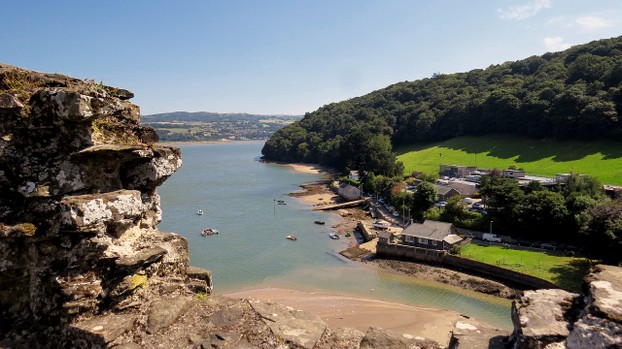There are good family walks based around the Sychnant Pass, a road route from the Conwy Valley to the plain between the two headlands that contains the town of Pen Maen Mawr. The Romans did not bother with this route as it would have taken them over the narrow strip of sand beneath the headland of Pen Maen Mawr [Big Stone Hill] which would be ideal for an ambush by the Britons,who would have found many a boulder to roll down onto the Romans. The route to Aber would have been the safer of the two. So the road up the Sychnant had to wait until the days of the mail coaches when it provided a better coach route than the tidal sands of Morfa Conwy.
The Sychnant gives access to several low hills: Conwy Mountain [Myndd yr Dref, Citadel Hill] Pen Maen Bach [Little Stone Hill] and Allt Wen [Fair Hill.] Pen Maen Bach is denuded rock, but Allt Wen is still well-vegetated. There are a few small stone circles in the vicinity known as Druid's circles. but this is a misnomer, as the cultus of stone circles antedates the druids by centuries, as it goes back to the Neolithic and Bronze Ages, whereas the druids were an Iron Age cultus of the oak. Still, they are worth a visit for their atmosphere.
Sadly, access to the privately owned Fairy Glen is now so difficult that I cannot recommend it as an attraction,even though I thoroughly enjoy the dancing of the exuberant stream through the enchanting woodland. But the area has good facilities for eating and drinking, so walks can culminate well.
One hill is Foel Lus. Foel is a mutated form of moel, which means bare hill. I cannot find a meaning for lus. It stands above the town like a huge pyramid with scree slopes. There is a route from the Sychnant over boggy ground, but at eighteen years old I ascended the slope directly. Scrambling up the steep slope was great fun. I took the opportunity to walk over to the slightly higher Craig Hafod Wen, which is a bit further from the town. This name means "The Crag of the Fair Farmstead."A hafod was a summer residence used in transhumance farming, the movement of animals from lower winter pastures to higher summer grazing.
It was on that walk that I was buzzed in a friendly way from a height by the mountain rescue helicopter. I had sat down on the slopes of Craig Hafodwen when the pilot must have seen my motionless figure, so suspecting a casualty he turned to investigate. In these circumstances DO NOT WAVE, as this makes the pilot think that you are seeking help. I just stood up and walked around. This was far preferable to what happened years later when a group of us were buzzed by a jet fighter, probably on a photo-bombing practise. That was scary, and I knew then the truth that my father told me, a fighter comes at you before you can respond. But he knew from grim experience!








 Pilgrimage. A review26 days ago
Pilgrimage. A review26 days ago
 Leo the Fourteenthon 05/09/2025
Leo the Fourteenthon 05/09/2025
 The Melsonby Hoardon 03/25/2025
The Melsonby Hoardon 03/25/2025


Comments
I do not know about military practices outside the UK.
The computer crashed before I could continue another component to my question below.
Are low-flying and photo-bombing strictly British Isles activities or do other countries, such as my own United States, do them also?
Thank you for your comment below in answer to my previous observation and question.
What is an example of remote areas for such activities as low-flying and photo-bombing?
No, it is known in the more remote areas, along with low flying.
Thank you for your comment below in answer to my previous observation and question.
Is this the only photo-bombing area on the east-pond side?
Photographs are taken and then studied to assess the accuracy of the bombers.
Thank you for your comment below on Nov. 13, 2020, in answer to my previous-day observation and question.
What is used instead of bombs to attack targets and what will be studied for its accuracy at practice end?
Photo-bombing! Fighter pilots practise by having cameras fitted in place of real bombs. They then "attack" a chosen target and on return their photos are studied for accuracy.
frankbeswick, Thank you for pictures, practicalities and products: I recognize Portmeirion from The Prisoner television series!
What is photo-bombing?
Another trace of Roman presence is botanical. Ground elder was introduced by the Romans as a salad vegetable, and now it has become an invasive weed that I was yesterday digging out of my allotment! Like the past, you cannot get rid of it!